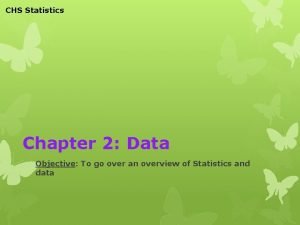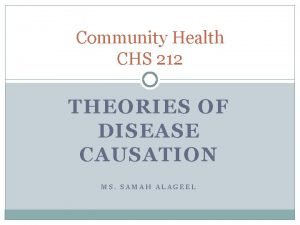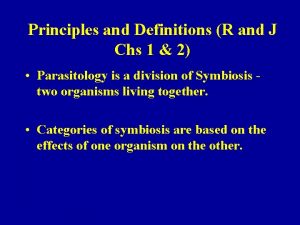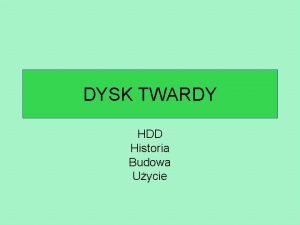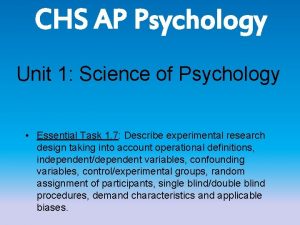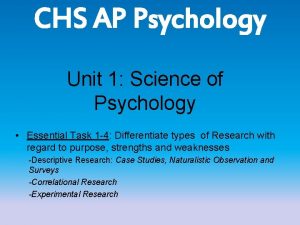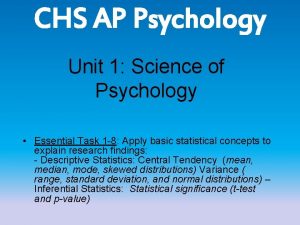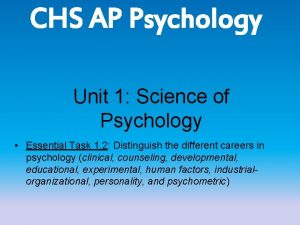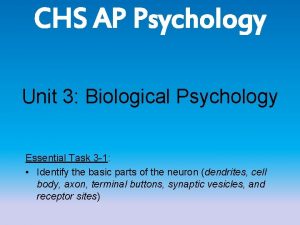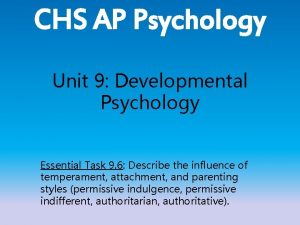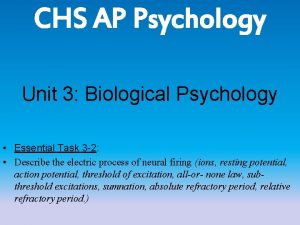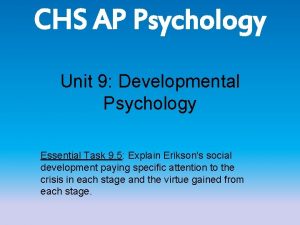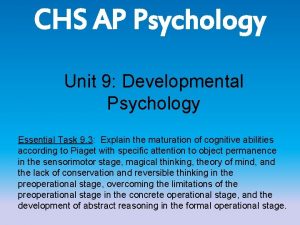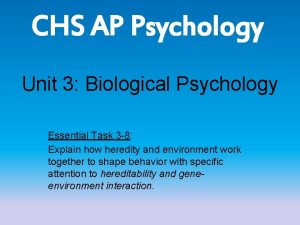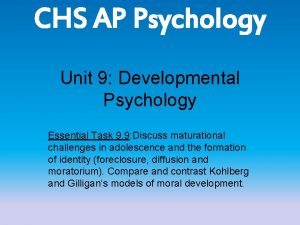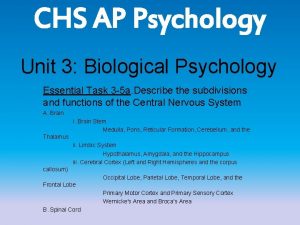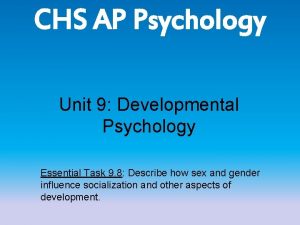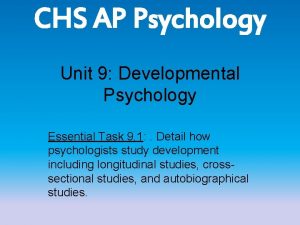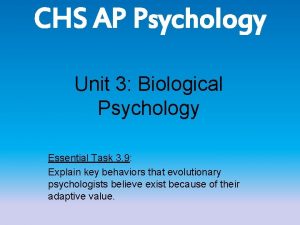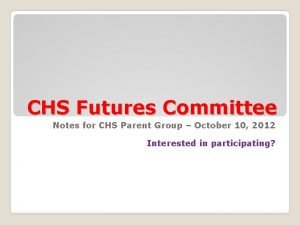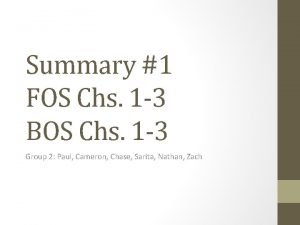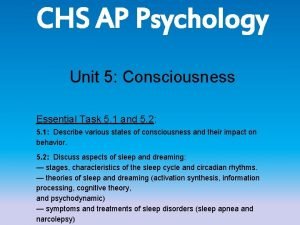CHS AP Psychology Unit 1 Science of Psychology






















- Slides: 22

CHS AP Psychology Unit 1: Science of Psychology • Essential Task 1. 6: Describe a correlational research study taking into account correlational coefficient, and scatter-plots.

Research Methods in Psychology • Correlational Research – Research technique based on the naturally occurring relationship between two or more variables – Used to make PREDICTIONS, such as the relation between SAT scores and success at college – Cannot be used to determine cause and effect • Asks: Do the two variables vary together?

Correlational Research • Purpose – to show relationship between two variables. Ø Strength – If you know how they are related you can predict outcomes. Ø Weakness – Correlation is not causation.

Scatter plots Scatterplot is a graph that comprises of points generated by values of two variables. • The slope of points depicts the direction • The amount of scatter shows the strength of relationship. Perfect positive correlation (+1. 00)

Scatter plots Perfect negative correlation (-1. 00) No relationship (0. 00) Scatterplot on the left shows a relation between the variables, and the on the right shows no relationship between the two variables.

Correlation Coefficient (r=) When one trait or behavior varies with another, we say the two correlate. Correlation Coefficient is a statistical measure of relationship between two variables. Indicates strength of relationship (0. 00 to 1. 00) Correlation coefficient r = + 0. 37 Indicates direction of relationship (positive or negative)

Correlation and Strength https: //www. youtube. com/watch ? v=Afnv. Fnzs 91 s

The Challenger: Data Table A Temp. 53 57 58 63 70 75 # of failures 2 1 Temperature 1 1 2 2 90 80 70 60 50 0 1 2 # of Failures 3

The Challenger: Data Table B Temp. # of failures 53 57 58 63 66 67 68 69 70 70 72 75 75 76 79 81 2 1 1 1 0 0 0 2 0 0 0 90 80 Temperature 70 60 50 0 1 2 # of Failures 3

Study of Low Self Esteem and Depression • You do the research because you assume the two are related • Compare two variables – Variable 1 = Score on a self-esteem test – Variable 2 = Length of a bout of depression in months

–Score on a self-esteem test –Length of a bout of depression in months

Correlation is NOT Causation or

Correlation is not Causation: It only predicts!!!! • Children with big feet reason better than children with small feet. – • (Children who are older have bigger feet than younger children; thus they can reason better) Study done in Korea: The most predictive factor in the use of birth control use was the number of appliances in the home. – (Those who have electrical appliances probably have higher socioeconomic level, and thus are probably better educated. )

Correlation is not Causation: It only predicts!!!! • People who often ate Frosted Flakes as children had half the cancer rate of those who never ate the cereal. Conversely, those who often ate oatmeal as children were four times more likely to develop cancer than those who did not. – Cancer tends to be a disease of later life. Those who ate Frosted Flakes are younger. In fact, the cereal was not around until the 1950 s (when older respondents were children, and so they are much more likely to have eaten oatmeal. )

Diet soda and weight gain? ? ? The study of more than 600 normalweight people found, eight years later, that they were 65 percent more likely to be overweight if they drank one diet soda a day than if they drank none. And if they drank two or more diet sodas a day, they were even more likely to become overweight or obese.

Third or Missing Variable Problem A relationship other than causal might exist between the two variables. It's possible that there is some other variable or factor that is causing the outcome. You don’t know this because you never controlled for those variables.

• Ice cream sales and the number of shark attacks on swimmers are correlated. • Skirt lengths and stock prices are highly correlated (as stock prices go up, skirt lengths get shorter). • The number of cavities in elementary school children and vocabulary size are strongly correlated.

There are two relationships which can be mistaken for causation: 1. Common response 2. Confounding

1. Common Response: Both X and Y respond to changes in some unobserved variable, Z. All three of our previous examples are examples of common response. (Ice Cream Sales) [Hot weather] (Murder Rates)

2. Confounding: X and Y respond to changes in some unobserved variables, A and B. A X [Summer jobs means more extra spending cash] (Ice Cream Sales) B Y [More people spend time together outside in crowded areas] (Murder Rates)

Illusory Correlations • Redelmeier and Tversky (1996) assessed 18 arthritis patients over 15 months, while also taking comprehensive meteorological data. Virtually all of the patients were certain that their condition was correlated with the weather. • In fact the actual correlation was close to zero. • Usually when the data in question stands out

Correlation is NOT Causation
 Baseball parent meeting agenda
Baseball parent meeting agenda Chs scaffolding
Chs scaffolding Chs or ibs
Chs or ibs Chs statistics
Chs statistics St robert ib boundary
St robert ib boundary Concept of disease
Concept of disease Chs module
Chs module Parasitism
Parasitism Chs investigations
Chs investigations Cms.edf.school
Cms.edf.school High school 101 class
High school 101 class Cylinder dysku
Cylinder dysku Chs investigations
Chs investigations My favorite subject is english
My favorite subject is english Unit 10, unit 10 review tests, unit 10 general test
Unit 10, unit 10 review tests, unit 10 general test Natural vs social science
Natural vs social science Mind map main branches of science
Mind map main branches of science Natural and physical science
Natural and physical science Applied science vs pure science
Applied science vs pure science Natural science and social science similarities
Natural science and social science similarities Wwwk-6.thinkcentral
Wwwk-6.thinkcentral Tragedy of the commons
Tragedy of the commons Windcube lidar
Windcube lidar



